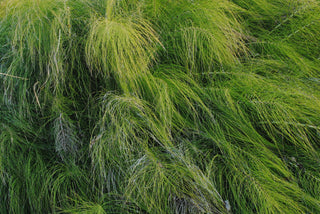
Single Herb library
Horsetail
Due to horsetails’ affinity for the kidneys, bladder, large intestine, and lung Dr Morse uses this herb in many of his formulas. You can try our single herb Horsetail Tincture, and enjoy this herb in Bone & Connective Tissue Support, Kidneys & Bladder Daily and Kidneys & Bladder Drain, Eye Health, and the Ultimate Herbal Blend.
At a Glance:
COMMON NAME: Horsetail, Scouring rush, Shave grass, Paddock-pipes, Canutillo Del Llano
LATIN BINOMIAL NAME: Equisetum arvense
FAMILY: Equisetaceae
PARTS USED: Aerial (above ground) parts
HABITAT: Prefers damp soil and shade but can grow in many plant communities in the northern hemisphere from sea level to 9,000 feet (about 2.74 km) and above. Harvest new shoots in the spring before they open and while they still resemble asparagus.
PRIMARY CONSTITUENTS: Silica, flavonoids, caffeic acid, minerals, saponins, tannins
Introduction:
Let's go back. Way, way back. It's the Carboniferous Period about 359 to 299 million years ago during the late Paleozoic Era. This geological time-scape predates the dinosaurs, and is dominated by giant insects: six-foot centipedes, mammoth cockroaches and foot long scorpions. Vast lowland swamps and shallow seas from this age decomposed for millions of years to become the coal deposits of North America that we burn today.
We come to this place to admire the foliage, specifically the giant horsetail that our modern-day Equisetaceae plant family descend from. Fossils of giant horsetail plants show specimens that grew up to 60 feet high. These horsetail skyscrapers are ferns, and like all ferns they reproduce by spores, not seeds.
Habitat and Cultivation:
Fast forward to today and these monolith primitive ferns have shrunk significantly, but not much else has changed. Modern horsetail (Equisetum arvense) still thrives in cool, dank wetlands, on the shores of rivers and lakes, and in open grasslands throughout North America and reproduces by spores.
Botanically, horsetail has maintained much of its prehistoric structure with its segmented stalk and whorled leaves, which botanically aren't leaves at all but toothed sheathes that resemble singular pine needles.
Horsetail plant prefers the northern sides of mountains, and areas of forest that provide ample shade. Springs, standing water, and waterways are all likely habitat for this ancient fern, but since horsetail is a native plant to much of the northern hemisphere, it can be found growing in many plant communities including Yellow Pine Forest, Red Fir Forest, Lodgepole Forest, Subalpine Forest, Foothill Woodland, Chaparral, Valley Grassland, and wetland-riparian.
Traditional Use
Considering how long this plant has been on the planet, it is no surprise horsetail plant has found its way into the traditional remedies of people across the globe. In Traditional Chinese Medicine, horsetail is called Mu Zei and it is said to have an affinity for the large intestine, lung, bladder, and kidneys. According to the White Rabbit Institue of Healing, Mu Zei clears damp heat, promotes a healthy inflammatory response, is styptic, and strengthens bones. Ancient Greek healers also used horsetail for its styptic nature, and to support the clearing of the bladder and urinary tract.*
Another common name is scouring rush as, when bundled and dried, horsetail is used to polish aluminum, copper, and wood, is said to be as strong as steel wool, and is used by musicians to polish the reeds of instruments.*
Specific Indications
Horsetail plant has some of the highest silica content when compared to other silica-rich herbs, containing about 5-10% dry weight silica.
Silica “is an essential nutrient for the structural integrity and development of connective tissue. The structures that horsetail nourish are the bones, teeth, joints, cartilage, hair, nails, skin and supple blood vessels. All structures with collagen will be supported by this herb.* Silica supports normal bone growth...Consider it any time you want to support collagen growth, collagen integrity or support any connective tissue." ~ Sharol Tilgner*
Horsetail is a must-have herb when supplementing to strengthen hair, skin, and nails. For this purpose, horsetail combines well with gotu kola and nettle.
*FDA warning: This statement has not been evaluated by the Food and Drug Administration. This product is not intended to diagnose, treat, cure, or prevent any disease.

